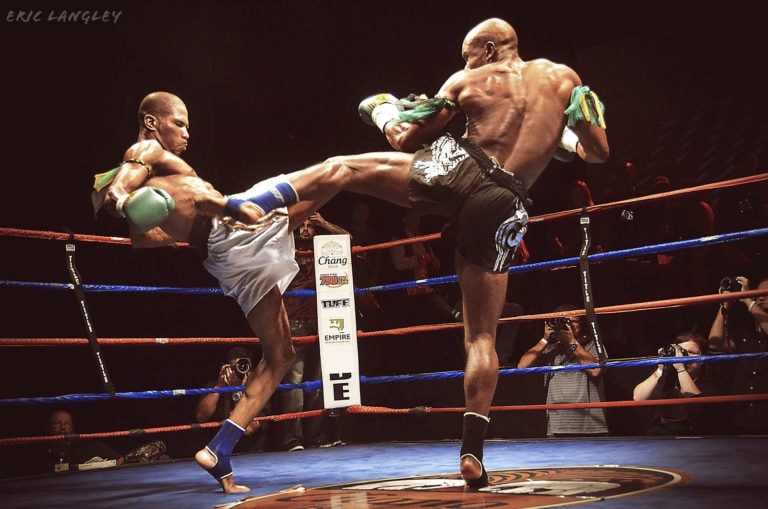Guide to Muay Thai Weight Classes and Divisions
Muay Thai is a combat sport that has gained immense popularity in recent years. Part of what makes it so captivating is the tradition and culture that come with it and the vast range of techniques that can be employed. Additionally, Muay Thai features a wide variety of weight classes and divisions, making it accessible to people of all sizes. In this guide, we will take a look at the different weight classes and divisions in Muay Thai and explain some of the basics of how they work.
Muay Thai, in general, has 17 weight classes. Some organizations have more, and some have less. The majority of weight classes have a 3 or a 4 pound (1.18 kg to 1.54 kg) difference between them. The most competitive weight classes in Thailand are the ones between 108 lbs and 126 lbs (49 kg to 57 kg), and outside Thailand, it’s the 143 lbs to 160 lbs classes (65 kg to 72 kg)
Muay Thai weight classes were established to ensure the safety of competitors. Each weight class has a different limit, and competitors must weigh-in within the specified range in order to compete. Muay Thai weight classes help to create a level playing field so that smaller fighters are not at a disadvantage when competing against larger opponents.
The Classes
Flyweights are the lightest weight class in Muay Thai, with a limit of 112 pounds (51 kilograms). This weight class is dominated by nimble and quick fighters who use their speed to their advantage. Since the Thais begin competing at such a young age and have smaller statures, most of them compete in the flyweight, bantamweight, and featherweight classes.
Junior bantamweights have a limit of 115 pounds (52 kilograms), and bantamweights have a limit of 118 pounds (53.5 kilograms).
Featherweights have a limit of 126 pounds (57.1 kilograms) and are characterized by their agility and quickness.
Lightweight fighters have a limit of 135 pounds (61 kilograms).
Welterweights have a limit of 147 pounds (66.7 kilograms).
Middleweights have a limit of 160 pounds (72.5 kilograms).
Supper Middleweights have a limit of 168 pounds (76.2 kilograms)
Light Heavyweights have a limit of 175 pounds (79.3 kilograms)
Cruiserweights have a limit of 200 pounds (90.71 kilograms)
Heavyweights are everyone over 200 pounds (90.71 kilograms)
These classes are according to the IBF Muay Thai divisions. They differ from the WBC Muay Thai, which has 19 divisions.
The Origin Of Weight Classes In Muay Thai
Since there are no weight classes on the battlefield, and as we know, the martial art of Muay Thai originated on the battlefield, there were no weight classes when it was first adopted as a combat sport. For a long period of time, there were only open weight classes in which fighters could fight anyone, heavier or lighter; it did not matter.
This weight difference was almost always advantageous to the heavier fighters since they could bully the lighter opponents, be stronger in the clinch, and produce more force with their punches, kicks, elbows, and knees. Even though there were some very skilled fighters that were at the lower range of the weight spectrum who could consistently defeat heavier opponents due to their skill, agility, and quickness of movement.
However, in the 20th century, Muay Thai was modernized into a regulated combat sport. It had to do so to expand its borders of influence across the planet. The modernization gave Muay Thai weight classes, padded boxing gloves instead of ropes, rounds, and rings.
The weight classes also kept the competition more fair and competitive since fighters could fight against someone who has almost equal weight to theirs, meaning the only thing that can make the difference during the fight and win is skill and persistence.
World Boxing Council Muay Thai Weight Classes
| Mini Flyweight | 105 lb (47.627 kg) |
| Light Flyweight | 108 lb (48.988 kg) |
| Flyweight | 112 lb (50.802 kg) |
| Super Flyweight | 115 lb (52.163 kg) |
| Bantamweight | 118 lb (53.524 kg) |
| Super Bantamweight | 122 lb (55.338 kg) |
| Featherweight | 126 lb (57.153 kg) |
| Super Featherweight | 130 lb (58.967 kg) |
| Lightweight | 135 lb (61.235 kg) |
| Super Lightweight | 140 lb (63.503 kg) |
| Welterweight | 147 lb (66.678 kg) |
| Super Welterweight | 154 lb (69.853 kg) |
| Middleweight | 160 lb (72.575 kg) |
| Super Middleweight | 168 lb (76.204 kg) |
| Light Heavyweight | 175 lb (79.379 kg) |
| Cruiserweight | 190 lb (86.183 kg) |
| Super Cruiserweight | 210 lb (95.254 kg) |
| Heavyweight | 230 lb (104.326 kg) |
ONE Championship Muay Thai Weight Classes
| Atomweight | 114.8 lb (52.2 kg) |
| Strawweight | 124.7 lb (56.7 kg) |
| Flyweight | 134.6 lb (61.2 kg) |
| Bantamweight | 144.8 lb (65.8 kg) |
| Featherweight | 154.7 lb (70.3 kg) |
| Lightweight | 169.6 lb (77.1 kg) |
| Welterweight | 184.5 lb (83.9 kg) |
| Middleweight | 204.6 lb (93.0 kg) |
| Light Heavyweight | 224.6 lb (102.1 kg) |
| Heavyweight | 264.5 lb (120.2 kg) |
International Kickboxing Federation Weight Classes
| Mini Flyweight | 105 lb (47.62 kg) |
| Junior Flyweight | 108 lb (48.99 kg) |
| Flyweight | 111 lb (50.35 kg) |
| Junior Bantamweight | 114 lb (51.71 kg) |
| Bantamweight | 118 lb (53.52 kg) |
| Junior Featherweight | 122 lb (55.34 kg) |
| Featherweight | 126 lb (57.15 kg) |
| Junior Lightweight | 130 lb (58.97 kg) |
| Lightweight | 135 lb (61.24 kg) |
| Junior Welterweight | 140 lb (63.5 kg) |
| Welterweight | 147 lb (66.68 kg) |
| Junior Middleweight | 154 lb (69.85 kg) |
| Middleweight | 161 lb (73.03 kg) |
| Super Middleweight | 168 lb (>76.2 kg) |
| Light Heavyweight | 175 lb (79.38 kg) |
| Super Light Heavyweight | 182 lb (82.55 kg) |
| Cruiserweight | 190 lb (86.18 kg) |
| Heavyweight | 210 lb (95.3 kg) |
| Super Heavyweight | No weight limit |
As you can see, different Muay Thai federations/organizations have different weight classes/divisions with the goal of making fights more competitive in their own way.
Why Is Cutting Weight A Thing?
Maybe you are wondering why do Muay Thai fighters cut weight then if there are weight classes. It is because it makes them more competitive in the fight. During the weight cut, fighters mostly lose water and fat; if they do the weight cut correctly, they will lose as few ounces or pounds of muscle as possible.
There are a few reasons why weight cutting is still a common practice in Muay Thai. First, it can help a fighter be more competitive in a lower weight class which is practically mitigated by the other fighter doing the same. Second, it can make a fighter’s punches and kicks more powerful as compared to the fighters in the lower weight class; it can also give them an advantage during the clinch.
Weight cutting is not without its risks, however. It can lead to dehydration, which can be dangerous. It can also make a fighter tired and sluggish. And if a fighter doesn’t make weight, he may not be able to compete. It is common practice to drop a lot of weight before a Muay Thai fight which can be dangerous, depending on the way it is done. A lot of fighters use sauna suits and eat barely anything while training in a hot and humid place like Thailand. The weight cut can have serious consequences on the fighters well being in the short and long term.
It is especially dangerous for Thai fighters since they have a lot of fights during their career, and they start fighting while they are still considered children.
Despite the risks, weight cutting is still a popular practice in Muay Thai. And it’s likely that it will continue to be so as long as fighters feel like they need an advantage over their opponents.
Some Thai fighters, however, can concede their weight advantage by choosing to fight a heavier opponent. The reason for, at first glance not so wise idea is that the lighter fighter can fight for a title in the higher weight class, meaning he can own two or even three belts for his victories. The other reason may also be cockiness or confidence; however you wish to call it, since, fighting against a bigger and stronger opponent and winning really is something to brag about.
Saenchai is one of the fighters who regularly fought heavier opponents and has won the majority of times. But Saenchai is a best of his own, a talent we haven’t seen or won’t see for a long time. His technique, patience, and playful way of fighting have won him more than 300 Muay Thai fights during his career.
Conclusion
Weight classes have come into existence in Muay Thai for the same reason they have in other combat sports, to even out the playing field. Fighters can fight their equals, at least in regards to weight, and show who truly has the better technique and skills. Weight classes ensure that no one wins solely because of their weight advantage. The most common weight classes in Muay Thai are the ones in the lower range of the weight spectrum, like flyweight and bantamweight. It is important to keep in mind that different organizations and federations have different weight classes unique to them.






